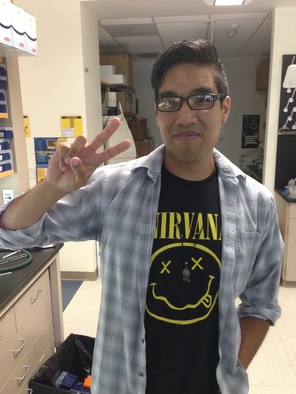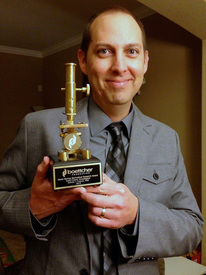|
Congratulations to Dr. Mark Gutierrez, our third PhD from the Franco Lab!!! Dr. Gutierrez successfully defended his PhD thesis, titled "Novel Requirements of the Synaptic Transmembrane Protein Csmd2 in Neuronal Maturation and Structural Plasticity." Mark's PhD program was Cell Biology, Stem Cells and Development (CSD).
0 Comments
Congratulations to Caitlin!!! Her paper was accepted at Developmental Biology! This is the third "I am pleased to inform you..." email for the lab in as many months! I could really get used to this.
Loss of Shh Signaling in the Neocortex Reveals Heterogeneous Cell Recovery Responses from Distinct Oligodendrocyte Populations The majority of oligodendrocytes in the neocortex originate from neural progenitors that reside in the dorsal forebrain. We recently showed that Sonic Hedgehog (Shh) signaling in these dorsal progenitors is required to produce normal numbers of neocortical oligodendrocytes during embryonic development. Conditional deletion of the Shh signaling effector, Smo, in dorsal progenitors caused a dramatic reduction in oligodendrocyte numbers in the embryonic neocortex. In the current study, we show that the depleted oligodendrocyte lineage in Smo conditional mutants is able to recover to control numbers over time. This eventual recovery is achieved in part by expansion of the ventrally-derived wild-type lineage that normally makes up a minority of the total oligodendrocyte population. However, we find that the remaining dorsally-derived mutant cells also increase in numbers over time to contribute equally to the recovery of the total population. Additionally, we found that the ways in which the dorsal and ventral sources cooperate to achieve recovery is different for distinct populations of oligodendrocyte-lineage cells. Oligodendrocyte precursor cells (OPCs) in the neocortical white matter recover completely by expansion of the remaining dorsally-derived Smo mutant cells. On the other hand, mature oligodendrocytes in the white and gray matter recover through an equal contribution from dorsal mutant and ventral wild-type lineages. Interestingly, the only population that did not make a full recovery was OPCs in the gray matter. We find that gray matter OPCs are less proliferative in Smo cKO mutants compared to controls, which may explain their inability to fully recover. Our data indicate that certain populations of the dorsal oligodendrocyte lineage are more affected by loss of Shh signaling than others. Furthermore, these studies shed new light on the complex relationship between dorsal and ventral sources of oligodendrocytes in the developing neocortex. Congratulations to Dr. Caitlin Winkler, our second PhD from the Franco Lab!!! Dr. Winkler successfully defended her PhD thesis, titled "Developmental Origins and Heterogeneity of the Neocortical Oligodendrocyte Lineage." Caitlin's PhD program was Cell Biology, Stem Cells and Development (CSD).
Congratulations to Mark!!! His paper was accepted at eNeuro! He's been working hard on this ever since he started in the lab a few years ago. When we first started we really had no idea where this was going to go, and we couldn't be happier with where Mark has taken it!
Csmd2 is a Synaptic Transmembrane Protein that Interacts with PSD-95 and is Required for Neuronal Maturation Mutations and copy number variants of the CUB and Sushi multiple domains 2 (CSMD2) gene are associated with neuropsychiatric disease. CSMD2 encodes a single-pass transmembrane protein with a large extracellular domain comprising repeats of CUB and Sushi domains. High expression of CSMD2 in the developing and mature brain suggests possible roles in neuron development or function, but the cellular functions of CSMD2 are not known. In this study, we show that mouse Csmd2 is expressed in excitatory and inhibitory neurons in the forebrain. Csmd2 protein exhibits a somatodendritic localization in the neocortex and hippocampus, with smaller puncta localizing to the neuropil. Using immunohistochemical and biochemical methods, we demonstrate that Csmd2 localizes to dendritic spines and is enriched in the postsynaptic density (PSD). Accordingly, we show that the cytoplasmic tail domain of Csmd2 interacts with synaptic scaffolding proteins of the membrane-associated guanylate kinase (MAGUK) family. The association between Csmd2 and MAGUK member PSD-95 is dependent on a PDZ-binding domain on the Csmd2 tail, which is also required for synaptic targeting of Csmd2. Finally, we show that knock-down of Csmd2 expression in hippocampal neuron cultures results in reduced complexity of dendritic arbors and deficits in dendritic spine density. Knock-down of Csmd2 in immature developing neurons results in reduced filopodia density, whereas Csmd2 knock-down in mature neurons causes significant reductions in dendritic spine density and dendrite complexity. Together, these results point toward a function for Csmd2 in development and maintenance of dendrites and synapses, which may account for its association with certain psychiatric disorders. Congratulations to Dr. Santiago Fregoso, our first PhD from the Franco Lab!!! Dr. Fregoso successfully defended his PhD thesis, titled "Transcriptional regulation of Cux2 in neural progenitors of the developing telencephalon: towards uncovering mechanisms of fate specification preceding neurogenesis." Santiago's PhD program was Cell Biology, Stem Cells and Development (CSD).
Congratulations to Santiago!!! His paper was accepted in Development! He put a ton of work into this project and took it in really interesting directions along the way. Really excited about this one!
Lmx1a drives Cux2 expression in the cortical hem through activation of a conserved intronic enhancer. During neocortical development, neurons are produced by a diverse pool of neural progenitors. A subset of progenitors express the Cux2 gene and are fate restricted to produce certain neuronal subtypes; however, the upstream pathways that specify these progenitor fates remain unknown. To uncover the transcriptional networks that regulate Cux2 expression in the forebrain, we characterized a conserved Cux2 enhancer that recapitulates Cux2 expression specifically in the cortical hem. Using a bioinformatic approach, we identified putative transcription factor (TF)-binding sites for cortical hem-patterning TFs. We found that the homeobox TF Lmx1a can activate the Cux2 enhancer in vitro Furthermore, we showed that Lmx1a-binding sites were required for enhancer activity in the cortical hem in vivo Mis-expression of Lmx1a in hippocampal progenitors caused an increase in Cux2 enhancer activity outside the cortical hem. Finally, we compared several human enhancers with cortical hem-restricted activity and found that recurrent Lmx1a-binding sites are a top shared feature. Uncovering the network of TFs involved in regulating Cux2 expression will increase our understanding of the mechanisms pivotal in establishing Cux2 lineage fates in the developing forebrain. Santiago attended the Gordon Research Conference on Neural Development and presented his poster, titled: "Regulation of Cux2 Expression in Neural Progenitors: Towards Uncovering Mechanisms of Fate Specification."
Mark attended the Gordon Research Conference on Cell Biology of the Neuron and presented his poster, titled: "Investigating the role of Csmd2 in Reelin-mediated Neuronal Maturation."
Congratulations to Caitlin!!! Her manuscript has been accepted at the Journal of Neuroscience! It's the culmination of a LOT of hard work over the last 4+ years, and she should be very proud of it! Thanks to Santiago and Brett for their work on the paper. A special thank you to our collaborators Odessa Yabut, Hector Gomez and Sam Pleasure from the Pleasure Lab at UCSF for a great collaboration.
The Dorsal Wave of Neocortical Oligodendrogenesis Begins Embryonically and Requires Multiple Sources of Sonic Hedgehog Neural progenitor cells in the developing dorsal forebrain give rise to excitatory neurons, astrocytes and oligodendrocytes for the neocortex. Compared to neurons and astrocytes, less is known about the molecular mechanisms that instruct dorsal forebrain progenitors to an oligodendrocyte fate. In this study, we show that Sonic hedgehog (Shh) signaling is required in dorsal progenitors for their late embryonic transition to oligodendrogenesis. Using genetic lineage-tracing in mice of both sexes, we demonstrate that the majority of oligodendrocytes in the embryonic neocortex derive from Emx1+ dorsal forebrain progenitors. Deletion of the Shh signaling effector, Smo, specifically in Emx1+ progenitors led to significantly decreased oligodendrocyte numbers in the embryonic neocortex. Conversely, knockout of the Shh antagonist, Sufu, was sufficient to increase neocortical oligodendrogenesis.Using conditional knockout strategies, we found that Shh ligand is supplied to dorsal progenitors through multiple sources. Loss of Shh from Dlx5/6+ interneurons caused a significant reduction in oligodendrocytes in the embryonic neocortex. This phenotype was identical to that observed upon Shh deletion from the entire CNS using Nestin-Cre, indicating that interneurons migrating into the neocortex from the subpallium are the primary neural source of Shh for dorsal oligodendrogenesis. Additionally, deletion of Shh from migrating interneurons together with the choroid plexus epithelium led to a more severe loss of oligodendrocytes, suggesting that the choroid plexus is an important non-neural source of Shh ligand. Together, our studies demonstrate that the dorsal wave of neocortical oligodendrogenesis occurs earlier than previously appreciated, and requires highly regulated Shh signaling from multiple embryonic sources. Caitlin, Santiago and Mark all attended the Society for Neuroscience Annual Meeting and presented posters.
Fregoso SPand Franco SJ. (2017) Mechanisms of Fate Specification in Cux2-expressing Neural Progenitors. Society for Neuroscience Annual Meeting, Washington, DC. Winkler CCand Franco SJ. (2017) Generation of cortical oligodendrocytes from dorsal forebrain radial glia requires Shh signaling during embryonic development. Society for Neuroscience Annual Meeting, Washington, DC. Gutierrez MAand Franco SJ. (2017) Investigating the role of Csmd2 in Reelin-mediated dendrite formation and synaptogenesis. Society for Neuroscience Annual Meeting, Washington, DC. Santiago attended the EMBO Conference on Gene Regulatory Mechanisms in Neural Fate Decisions and presented his poster, titled: "Regulation of Cux2 Expression in Neural Progenitors: Towards Uncovering Mechanisms of Fate Specification."
The lab was awarded a 1-year Grand Challenges Grant from the Linda Crnic Institute for Down Syndrome. The title of the grant is: "Defects in Neurogenesis and Neuronal Migration in DS Mouse Models: Elucidating the Developmental and Molecular Mechanisms."
Caitlin attended the Cold Spring Harbor Laboratory conference on Glia in Health and Disease. She presented her research in a poster titled "Activation of a ventral pathway in dorsal forebrain progenitors initiates cortical oligodendrogenesis."
Welcome to our newest lab member, Mark Gutierrez! Mark is a second-year student in the Cell Biology, Stem Cells and Development graduate program.
Caitlin, Brett and Santos attended the Society for Developmental Biology Annual Meeting in Snowbird, UT. Caitlin and Brett presented a poster on a new genetic tool being developed in the lab. We hung out with the marmots (not a typo) and potguts (also not a typo), and saw a raccoon family go fishing the garbage can. We also saw a Christian Bale painting at the SLC Temple Square. We may or may not have locked ourselves out of our condo and had to eat lunch in the street. Click here to learn more.
Santos received a 3-year Webb-Waring Biomedical Research Grant from the Boettcher Foundation, for his proposal on Brain Stem Cells in Development and Disease.
We got our first grant! Santos received a 1-year pilot grant from the Center for NeuroScience (CNS) and Colorado Clinical and Translational Sciences Institute (CCTSI). The title of the grant is: "Novel interactors of the Reelin signaling pathway and their potential roles in healthy brain function and Alzheimer's disease pathology."
Santos and Caitlin attended the Gordon Conference on Neural Development in Newport, RI. Caitlin presented her first poster from the Franco lab! We may or may not have skipped a session to watch Guardians of the Galaxy at the movie theater. We also may or may not have spent some time in the ER getting stitches after a happy hour "incident." Click here to learn more.
Santos presented a poster at the Society for Developmental Biology Annual Meeting in Seattle, WA.
Santiago and Caitlin both passed their preliminary exams!!!
|


 RSS Feed
RSS Feed